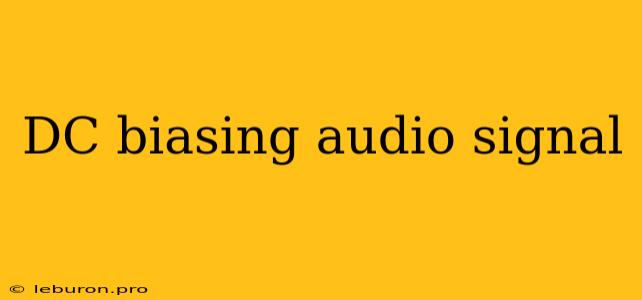DC Biasing: A Crucial Step in Audio Signal Processing
In the realm of audio signal processing, understanding the concept of DC biasing is paramount. It plays a vital role in ensuring that audio signals are transmitted and processed effectively, preserving their integrity and fidelity. DC biasing involves introducing a small DC voltage to an audio signal, which serves as a reference point, enabling proper signal amplification and preventing distortion. This article will delve into the intricacies of DC biasing, exploring its significance, different types, and practical applications.
The Need for DC Biasing
Audio signals, by their very nature, are AC (alternating current) signals, fluctuating around zero volts. However, many audio components, particularly amplifiers, operate with a predetermined voltage range. To accommodate these signals within the operating range of the amplifiers, DC biasing is employed. Here's why it's essential:
1. Amplification and Signal Integrity
Without DC biasing, an audio signal would fluctuate around zero volts. This would place the signal in the amplifier's non-linear region, leading to distortion and clipping. By introducing a DC bias , the signal is shifted to a point within the amplifier's linear operating range, ensuring accurate amplification without distortion.
2. Class AB Amplification
In Class AB amplifiers, transistors operate in both the linear and non-linear regions. To prevent crossover distortion, which occurs when the signal transitions between the transistors, DC biasing is crucial. It ensures a smooth transition and eliminates the audible "crossover" artifacts.
3. Zero-Crossing Detection
Some audio processing circuits rely on detecting zero crossings in the audio signal. DC biasing is essential in these cases because it provides a stable reference point for accurate zero-crossing detection.
Types of DC Biasing
Several methods are employed for DC biasing audio signals, each with its specific characteristics and suitability:
1. Voltage Divider Bias
This method utilizes a voltage divider circuit consisting of resistors to create a specific DC voltage at the input of the amplifier. It's a simple and cost-effective technique, but it may not be suitable for high-frequency signals due to the inherent capacitance of the resistors.
2. Emitter Bias
In emitter bias, a resistor is connected to the emitter terminal of a transistor. This resistor provides a DC path to ground, establishing a bias voltage. Emitter bias is often employed in Class A amplifiers for its stability and simplicity.
3. Emitter Follower Bias
This method utilizes an emitter follower circuit, where the input signal is coupled to the base of a transistor, and the output is taken from the emitter. DC biasing occurs naturally within the circuit due to the voltage drop across the emitter resistor. Emitter followers are known for their high input impedance and low output impedance.
4. Current Source Bias
Current source biasing uses a current source to provide a constant current to the base of the transistor. This method offers excellent stability and is well-suited for high-power amplifiers.
Consequences of Incorrect DC Biasing
While DC biasing is crucial for audio signal processing, incorrect or absent DC biasing can lead to several undesirable effects:
1. Distortion
As mentioned earlier, without proper DC bias, the signal will operate within the non-linear region of the amplifier, causing distortion. This distortion can manifest as clipping, crossover distortion, or other unwanted artifacts.
2. Offset
Incorrect DC biasing can introduce a DC offset into the audio signal. This offset can cause problems with downstream audio components that are sensitive to DC voltages, resulting in a hum or buzz in the audio output.
3. Instability
Improper DC biasing can lead to instability in amplifiers, causing oscillations or unwanted feedback.
Measuring and Adjusting DC Bias
DC biasing can be measured using a multimeter or oscilloscope. By connecting the multimeter to the output of the amplifier or other audio component, one can measure the DC voltage present. Adjustments to DC bias are typically made through variable resistors or potentiometers in the circuit.
Applications of DC Biasing
DC biasing finds numerous applications in audio signal processing, including:
1. Audio Amplifiers
DC biasing is fundamental to audio amplifiers, ensuring proper signal amplification and preventing distortion.
2. Audio Preamplifiers
Preamplifiers are often used to boost weak audio signals. DC biasing is crucial in preamplifiers to prevent signal degradation and maintain signal fidelity.
3. Audio Equalizers
Equalizers use DC biasing to adjust the frequency response of audio signals.
4. Audio Filters
Filters often employ DC biasing to achieve specific filtering characteristics.
Conclusion
DC biasing is an indispensable technique in audio signal processing, ensuring proper amplification, preserving signal integrity, and preventing distortion. Understanding its principles and applications is crucial for audio engineers and technicians alike. By carefully selecting and adjusting DC bias levels, one can optimize audio signal quality and create a rich, enjoyable listening experience.
